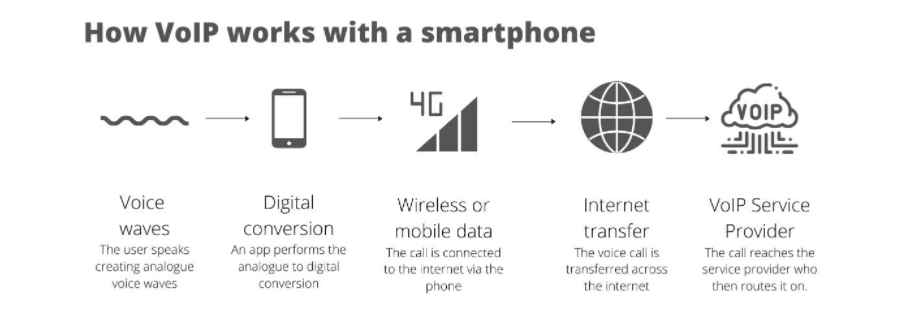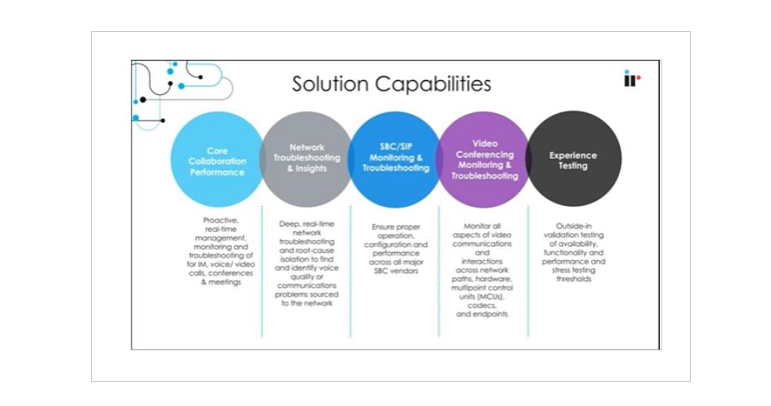With the advent of remote working, employees are no longer tethered to their desks, or restricted by hard-wired equipment. As long as there is a reliable internet connection, and a VoIP phone connection of course, the lines of communication and collaboration remain open. In this guide, we'll provide all the information you need on VoIP testing. From how to achieve Quality of Service metrics, to what you should do about poor call quality, slow download speeds, network failures and more.
Read more about how you can prevent network and technology issues with our Guide on Testing your Technology Ecosystem.

Read more about how you can prevent network and technology issues with our Guide on Testing your Technology Ecosystem.
How does VoIP work?
Voice over Internet Protocol (VoIP) converts analog voice calls into packets of data. These packets travel in the same way as any other type of data, like email or text messages, over the public Internet and/or any private Internet Protocol (IP) network.
Using a VoIP service, you can call landlines or cell phones. With a VoIP call, you can also call computer-to-computer, with both parties speaking into a microphone and listening through computer speakers or headsets.
How VoIP benefits a business
By adding voice to a data network connection, most businesses find that they can dramatically reduce costs, improve productivity, and enhance collaboration.
- Save costs by managing one network instead of two, yet you can easily add, move, or change phone extensions and locations, creating infinitely more flexibility without additional outlay.
- VoIP has greatly benefited businesses since the COVID-19 pandemic forced the new remote working dynamic by enabling communications system from home or on the road. Also, wireless IP phones connect users to your communications system and data resources. This means users can upload and download data from your network - from any location, wirelessly.
- VoIP capabilities in enhance unified communications and collaboration. With a unified communications solution, workers can easily collaborate through voice, video chat, web conference, and instant messaging. Employees can communicate using each technology individually or all of them simultaneously, and from a single, easy-to-use interface.



Image source: T2K Hosted VoIP
The impact of poor VoIP connection
A bad VoIP connection will compromise call quality and ultimately impact the communication between your team, colleagues, clients or customers. A poor internet service or limited internet speed, means you won’t be able to maintain multiple lines on the network.
This in turn results in delay, as customers spend more time waiting in a queue. Metrics show that sales teams can lose up to 60% of their customers if their call isn't answered in less than a minute - ideally it should be 30 seconds or less.
How can a VoIP test help?
While VoIP is an essential component of enterprise communications, calls through VoIP can be difficult to manage and troubleshoot. Packet loss, jitter and VoIP latency are the three elements that most influence call quality. Legacy VoIP monitoring systems rely on Call Detail Records (CDRs), and at best, packet capture will only highlight issues after something has already gone wrong. This reactive approach also provides little or no visibility across multiple networks.
Legacy VoIP monitoring software struggles even more as enterprises migrate to cloud-based UC solutions. VoIP data packets are especially susceptible to underlying network conditions that most VoIP monitoring software can't detect.
So, a stable and capable VoIP connection is important for every business. A VoIP test helps you review the overall health of your network connection within a matter of seconds. It also enables you to determine whether the call traffic in your existing phone system is high enough to warrant an upgrade.
If VoIP test results indicate certain properties such as bandwidth, jitter or latency falling short of the minimum requirements, it could mean that it's time to switch your service provider, or look into more powerful VoIP systems that can more efficiently meet your business requirements.
Why is a VoIP quality test important?
First, VoIP testing gauges the capability of your internet connection to handle VoIP services. Second, by running a VoIP quality test, you can evaluate the VoIP performance from a user's point of view. Leveraging VoIP quality testing can also help you to find the right VoIP system for your business, including software and hardware.
Where do I start with VoIP testing?
The quality of VoIP service is determined by how devices, such as computers, routers, SIP phones and servers, relay internet traffic to and from each other. There are three primary factors that affect the way VoIP traffic flows.
- VoIP service provider
- Network/router settings
- ISP connection
VoIP connection problems usually start with degraded audio quality. This can include choppy, spliced and inaudible call segments. VoIP tests, ping tests and traceroutes can all help pinpoint what's wrong. When you know that your VoIP network is experiencing issues you need more enough information to fix the problem.
To do that, you have to locate and identify which part of the network is causing the issue.. Ping testing is a simple procedure that can help pinpoint where your network traffic is experiencing issues, so that you can accurately troubleshoot.
What is a ping test?
When a network or phone system is experiencing delays or issues, a ping is used as a diagnostic tool for assessing where this is occurring. Specifically, it provides data on how well an internet-enabled device like a router, communicates with another endpoint on the internet. It accomplishes this by sending an ICMP (Internet Control Message Protocol) packet, or 'ping', to the desired destination.
ICMP packets are specifically designed to test network performance. As such, they contain almost no information, and therefore take up very little bandwidth. If the ICMP packet reaches the receiving device, that device will recognize the ping request and reply back to the original device. The total time it took for the packet to be transmitted from and return to the original device is recorded as 'ping time' or 'round trip time'.
What is a VoIP test?
If your calls are failing altogether, you can troubleshoot by running a VoIP test - an app that measures the speed, jitter and latency of your internet connection. Also known as a VoIP speed test, it's a way to check if your bandwidth is enough to support VoIP calling. Bandwidth determines upload and download speeds -and how fast call data travels between users. The more bandwidth that's available, the faster your connection, allowing more simultaneous VoIP calls.
Each VoIP call requires around 100kbps of upload and download speed. Technical experts recommend you should assume that one tenth of your employees will be on the phone at any given time. But if you have repeated issues with calls during peak business time, it could mean you need to talk to your ISP about increasing your bandwidth.
Check out our comprehensive guides for more about support, monitoring, understanding and fixing latency, jitter and packet loss.
What is a traceroute and how does it work?
When your VoIP service deteriorates, you can perform a command known as a traceroute on your computer to see if there are problems with your internet connection, your hosted VoIP provider, or an intermediate router somewhere else in the network.
While it seems like the loading time of your internet is instantaneous, the request that you send from your computer doesn't actually travel nonstop from Point A to Point B. Actually, your online data must travel through many devices, primarily routers, before it reaches its final destination, and vice versa.
A traceroute maps how internet data travels from your computer to your intended destination. The traceroute documents the intermediary devices and measures how long it takes for data to travel from your computer to each point.
When looking at the results of a traceroute, you're determining not just what the problem is, but where on your system it is. The advantage of using a traceroute is that it can tell you where a problem exists - whether it's your ISP, your service provider, or your own equipment that's responsible.
If you've identified that the router that may be causing a network issue, you can perform a ping test to determine if it is the cause of jitter, packet loss, latency or other errors.
A traceroute may show that your connection is having trouble with devices associated with your ISP. This degradation should be obvious immediately across all internet activities, not just calls. In this case, you need to review your Service Level Agreement.
Understanding Quality of Service (QoS)
Poor voice quality can be extremely frustrating for your employees as well as your customers, and can negatively affect your business. Here are some things to look out for that can help with voice quality. A key feature to look for, and to make sure your users can adjust for themselves, is Quality of Service (QoS). QoS is a feature available within network switches that enables you to prioritize voice traffic. QoS ensures that you have enough bandwidth for high quality of VoIP, regardless of what else is happening within your UC infrastructure.
Make sure your router is VoIP-friendly
Standard home or small business routers don't have the capacity to transmit your business VoIP calls. Whether you're working remotely, or an IT professional who is managing a large number of home-based network infrastructure, ensure that your wireless routers have the ability to expressly prioritize VoIP traffic over other types of traffic. It's also important that your router supports SIP, which helps to deliver data reliably between the client and the server. You'll also want virtual LAN (VLAN) support, which helps to group and disperse data based on where latency is lowest.
Phone interference issues
Phones with higher GHz frequencies tend to produce interference. A typical VoIP phone runs at 2.4 GHz. However, there are also 5.8 GHz phones on the market. In general, the 2.4 GHz band provides a longer range but its data throughput is slower. The 5 GHz band provides less coverage, but allows data to flow faster.
The importance of monitoring and performance management solutions
The methods outlined in this guide for troubleshooting and managing VoIP call quality are good to know, and may help solve some your problems in the short term. However, large organizations can't afford to manage VoIP issues reactively. In fact without proactive solutions in place to monitor, diagnose, test and identify issues in real time, organizations risk compromising their entire UC infrastructure.
The challenges of remote working and BYOD
Bring Your Own Device (BYOD) is a fact of life with remote working. It enables workers to use their own mobile devices but still connect with the workplace network infrastructure. But this presents huge complexity in keeping track of disparate software and hardware that can contribute to issues with call quality.
VoIP monitoring tools can not only troubleshoot problems as they happen, but they come with an intuitive user interface that can identify the likelihood of recurring issues in real time.
Performance management solutions that monitor VoIP allow complete visibility into what could impact VoIP traffic and QoS. For example, whether backups are using up your bandwidth, or a router is misconfigured. Stress testing generates large loads into the system in a controlled fashion so you can confirm that the system is 100% connected to the telephone network and all SIP channels are available. All this and more, from a single dashboard.
IR Collaborate takes network monitoring to the next level, giving enterprises valuable insights into how their VoIP infrastructure is performing by picking up on performance related issues.
Read more about how you can prevent network and technology issues with our Guide on Testing your Technology Ecosystem.

Read more about how you can prevent network and technology issues with our Guide on Testing your Technology Ecosystem.






